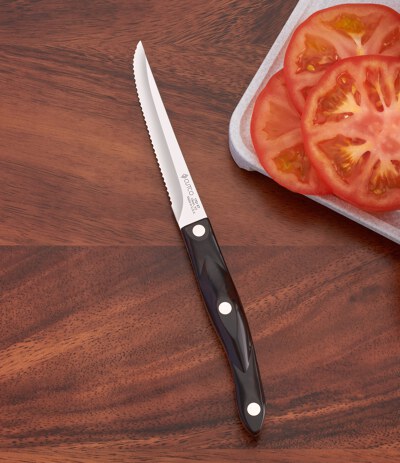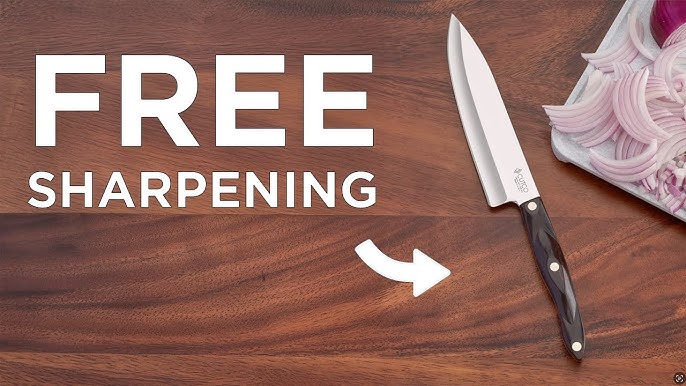Your Cutco knives are more than just tools—they’re an investment in your cooking experience. When they start to lose their edge, you might feel frustrated or even tempted to replace them.
But what if you could bring back that sharpness quickly and easily? In this guide, you’ll discover simple, effective ways to sharpen your Cutco knives right at home. Keep reading, and you’ll learn how to keep your blades razor-sharp, making every slice smoother and safer.
Ready to unlock the full potential of your knives? Let’s get started.

Credit: www.amazon.ca
Choosing The Right Sharpening Tools
Choosing the right sharpening tools is crucial for maintaining the sharp edge of your Cutco knives. The tool you select affects how efficiently you sharpen and how long the blade stays sharp. Picking the wrong tool can damage the blade or wear it down faster, so understanding your options helps you protect your investment.
Whetstones And Their Grit Levels
Whetstones are a classic choice for sharpening Cutco knives. They come in various grit levels, usually ranging from coarse to fine. Coarse grits (200-600) remove more metal and fix dull or damaged edges, while medium grits (800-1500) refine the blade, and fine grits (3000-8000) polish it to a razor-sharp finish.
Choosing the right grit depends on your knife’s condition. If your blade feels dull or nicked, start with a coarser stone and finish with a finer one. Have you noticed how a polished edge lasts longer? That’s the power of using a high-grit stone.
Using Honing Rods Effectively
Honing rods aren’t for sharpening but for realigning the blade’s edge. Using them regularly keeps your Cutco knives sharp between sharpening sessions. Ceramic and steel rods are common; ceramic rods are gentler and ideal for frequent use, while steel rods handle tougher maintenance.
Hold the rod vertically and swipe the knife edge at a 20-degree angle. This simple routine can save you from frequent sharpening. Do you often skip honing, only to find your knife dull too soon? This small habit can make a big difference.
Electric Sharpeners For Cutco Knives
Electric sharpeners offer speed and convenience, especially if you’re short on time. Look for models designed for fine edge knives to avoid removing too much metal. Some electric sharpeners come with multiple stages, from coarse to fine, making the process straightforward.
However, they can be less precise than manual methods. If you want control over the sharpening angle and pressure, manual tools might serve you better. Think about how much time you want to invest versus the level of sharpness you need.

Credit: www.youtube.com
Preparing Your Knife For Sharpening
Preparing your Cutco knife for sharpening is an important step. It ensures the blade is clean and ready for the sharpening process. Proper preparation also makes sharpening safer and more effective. Taking time to prepare your knife helps keep it sharp longer and protects the blade from damage.
Cleaning And Inspecting The Blade
Start by washing the blade with warm water and mild soap. Remove any food residue, grease, or dirt. Dry the blade completely with a soft cloth. Next, check the blade for any chips or cracks. Look closely along the edge for any damage. A damaged blade may need professional repair before sharpening. Make sure the handle is secure and free of cracks. A loose handle can be dangerous during sharpening.
Setting Up A Safe Sharpening Area
Choose a clean, flat surface with good lighting. Clear the area of any clutter or distractions. Use a non-slip mat or towel under your sharpening tool. This prevents slipping and keeps the blade stable. Keep your hands dry to avoid slipping. Make sure children and pets are away from the sharpening space. Have all your sharpening tools within reach before starting. Safety first for a smooth sharpening process.
Step-by-step Sharpening Process
Sharpening your Cutco knives properly can breathe new life into your kitchen tools. The process requires attention to detail and patience, but the results are worth the effort. Let’s walk through the sharpening process that will keep your knives cutting smoothly and safely.
Maintaining The Correct Angle
Keeping the right angle is crucial for effective sharpening. Aim for about a 20-degree angle between the blade and the sharpening tool. Holding the knife too steep or too flat can damage the edge or make sharpening ineffective.
Try visualizing the angle by comparing it to stacking two pencils. This simple trick helps you maintain consistency. Can you feel how a steady angle changes the sharpness quickly?
Sharpening Strokes And Pressure
Use smooth, even strokes along the blade’s edge. Move the knife from the base to the tip, following the curve naturally. Avoid short, choppy motions as they can wear down the blade unevenly.
Apply moderate pressure—too much can ruin the blade, too little won’t sharpen effectively. Think of it like brushing your teeth: firm but gentle strokes work best. How does adjusting pressure change your sharpening results?
Flipping And Repeating For Both Sides
After sharpening one side, flip the knife and repeat the same process on the other side. This balance keeps the edge even and sharp. Neglecting one side can cause the blade to become crooked and dull faster.
Count the strokes on each side to ensure you give equal attention. This simple habit makes a noticeable difference in sharpness and longevity. Are you ready to treat both sides with equal care?
Finishing Touches For A Razor Edge
Finishing touches are key to achieving a razor-sharp edge on your Cutco knives. These final steps polish the blade and perfect its cutting ability. A smooth, refined edge means safer and more efficient slicing every time.
Honing To Refine The Edge
Honing realigns the microscopic teeth on the blade’s edge. Use a honing rod with a smooth, steady motion. Hold the rod vertically and draw the knife down at a 20-degree angle. Repeat this on both sides of the blade.
Honing does not remove metal but sharpens the edge by straightening it. This step keeps your knife sharp longer between full sharpenings.
Testing Sharpness Safely
Test your knife’s sharpness carefully to avoid accidents. Slice through a piece of paper or a tomato gently. A sharp knife will cut cleanly without tearing or squashing.
Never test sharpness by touching the blade directly. Use safe methods to ensure your knife is ready for use.
Common Mistakes To Avoid
Sharpening Cutco knives needs care and attention. Avoiding common mistakes keeps blades sharp longer. Mistakes can damage the blade or reduce its life. Learning what to avoid helps maintain cutting performance.
Over-sharpening And Metal Loss
Sharpening too often wears down the knife’s metal. Each sharpening removes a thin layer of steel. Over-sharpening makes the blade thinner and weaker. It can cause chips or cracks over time. Sharpen only when the blade feels dull or struggles to cut.
Incorrect Angles And Uneven Edges
Using the wrong angle affects the knife’s sharpness. Cutco knives usually need a 20-degree angle. Sharpening at too steep or flat an angle dulls the blade quickly. Uneven edges cause poor cutting and jagged cuts. Keep a consistent angle during the entire sharpening process.

Credit: cutco.com
Maintaining Your Cutco Knives Between Sharpening
Maintaining your Cutco knives between sharpening keeps them sharp longer and safe to use. Proper care prevents damage and ensures smooth cutting every time. Simple habits can protect the blade and handle. Consistent maintenance saves money and effort on frequent sharpening.
Proper Storage Tips
Store knives in a dry place to avoid rust. Use a knife block or magnetic strip to keep blades separate. Avoid tossing knives in a drawer with other utensils. This prevents nicks and dull edges. Always clean and dry knives before storing. Keep blades away from moisture and humidity.
Regular Honing Schedule
Honing realigns the blade edge without removing metal. Use a honing steel every few uses for best results. Hold the steel vertically and swipe the blade at a 20-degree angle. Repeat on both sides of the knife. Honing keeps blades sharp and ready between sharpenings. It improves cutting precision and safety.
Frequently Asked Questions
How Often Should I Sharpen Cutco Knives?
Sharpen Cutco knives every 6 to 12 months for optimal performance. Frequent use may require more frequent sharpening. Regular maintenance keeps blades sharp and safe.
What Tools Are Best To Sharpen Cutco Knives?
Use a Cutco Sharpener, whetstone, or professional sharpening service. Avoid electric sharpeners that can damage the blade. Proper tools ensure precision and blade longevity.
Can I Sharpen Cutco Knives At Home?
Yes, you can sharpen Cutco knives at home using a Cutco Sharpener or whetstone. Follow instructions carefully to avoid damaging the blade. Home sharpening saves time and money.
How Do I Know If My Cutco Knife Needs Sharpening?
If your knife struggles to cut or tears food, it needs sharpening. Dull blades require more force and increase injury risk. Test by slicing paper or tomatoes.
Conclusion
Sharpening Cutco knives keeps them effective and safe to use. Regular care extends their life and improves cutting. Use the right tools and follow steps carefully. Always check your knife’s edge before and after sharpening. A sharp knife makes cooking easier and more enjoyable.
Keep your knives sharp for better results every time. Simple maintenance saves money and time in the long run. Stay patient and practice for the best sharpening skills. Your Cutco knives will thank you with every slice.

